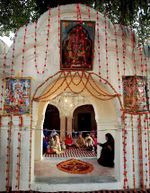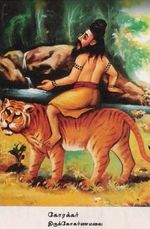Gorakhnath
Gorakshanath, also known as Gorakhnath, was an 11th to 12th century[1]Nath yogi, connected to Śaivism as one of the two most important disciples of Matsyendranath, the other being Caurangi.
Biography[edit]
Traditionally, Guru Gorakshanath is believed to have been born sometime in the 8th century, although some believe he was born hundreds of years later. He traveled widely across the Indian subcontinent and accounts about him are found in some form in several places including Afghanistan, Baluchistan, Punjab, Sindh, Uttar Pradesh, Uttarakhand, Nepal, Assam, Bengal, Kathiawar,[2] Maharashtra, Karnataka and even Sri Lanka.
Nāth Sampradāya[edit]
There are varying records of the spiritual descent of Gorakshanath. All name Adinath and Matsyendranath as two teachers preceding him in the succession. Though one account lists five gurus preceding Adinath and another lists six teachers between Matsyendranath and Gorakshanath, current tradition has Adinath identified with Lord Śiva as the direct teacher of Matsyendranath, who was himself the direct teacher of Gorakshanath.[3]
The Nāth tradition underwent its greatest expansion during the time of Gorakshanath. He produced a number of writings and even today is considered the greatest of the Nāths. It has been purported that Gorakshanath wrote the first books on Laya yoga. In India there are many caves, many with temples built over them, where it is said that Gorakshanath spent time in meditation. According to Bhagawan Nityānanda, the samādhi shrine[4] of Gorakshanath is at Nāth Mandir near the Vajreshwari temple about one kilometer from Ganeshpuri, Maharashtra, India.[5] According to legends Gorakshanath and Matsyendranath did penance in Kadri Temple at Mangalore, Karnataka.They are also instrumental in laying Śivlingam at Kadri and Dharmasthala. The temple of Gorakhnath is also situated on hill called Garbhagiri near Vambori.[6]
Legends[edit]
One legend states that Guru Gorakshanath, the "eternal sage" traditionally associated with Haṭha Yoga, has been around for thousands of years watching the welfare of humanity. Other legends ascribe different stories to his birth and the period of his worldly existence, and they vary greatly. The Nāth Rahasya, which literally translates as "the mystery of the masters", recounts the birth, work, and death of nine such Nāths;[7] and Guru Gorakshanath was the ninth Nāth, preceded by his Guru, the eighth Nāth, namely, Matsyendranath.
There is no confirmed theory of where Gorakhnath was born and several theories have risen from different parts of India where the locals of distinct ethnic region claim Gorakhnath was born in their region. One myth says he was born in Tilla, near Jhelum, in Punjab while another claims that Gorakhnath was originally a Buddhist named Ramnavajra.[8] Another theory is that he was born in Assam,[9] and a fourth theory that he was born Uttar Pradesh.[10] A fifth theory is that he was born in the Kathiawar Peninsula of Gujarat.[11]
Ahomi and Bengali tradition[edit]
The Bengali Community located in these states and neighboring country of Bangladesh have a sizable number of Yogi Brahmins(Also called Rudraja Brahmins/ Jugi Nath) who have taken their name from this saint. The prominent surnames used by them are Nath, Debnath, Majumdar, Deb Sharma and some others. They are not considered traditional Brahmins though and this creates confusion regarding their exact caste status. Some of the sections of them have been included as OBC[12] by the Government of India.
Gujarati tradition[edit]
While legends claim and suggest for Guru Gorakhnath were born in Kathiawar, influence of Nātha Sampradāya, tributary monuments, places and followers of Guru Gorakhnath and Guru Matsyendranath are found across Gujarat, more in Kathiawar - Saurashtra region. Eventually, there are already some Natha Yogis born in Kathiawar, namely Neminath, Baba Balak Nath and Gebinath.
Faith, followers, hermits and ashrams denoting to Nātha sect, Guru Gorakhnath and their lineage are often found in the region covering interiors of Junagarh, Bhavnagar, Porbandar, Amreli, Rajkot districts, a few places in Kutch and particularly Girnar range in Saurashtra. There is a famous Gorakhnath Temple in Junagadh, while Saurashtra's coastal stretches from Bhavnagar to Dwarka have few interesting spots relating Guru Gorakhnath, including a village called Gorakhmadhi situated near Prabhas Patan, Somnath which is dedicated to Guru Gorakhnath. There is a distinct Gorakhnath Temple in Bhuj, Kutch too.
Hindi tradition[edit]
There are accounts of Sant Kabir having met Gorakhnath.
Kashmiri tradition[edit]
After some years, Mahayogi Guru Gorakṣanath, a Hindu yogi who dreamt of the episode between Vaiṣnavi and Rama, wanted to know if the Goddess Vaiṣno Devi had really attained a higher spiritual level. Therefore he sent his most devout follower, Bhairo Nath, to the Trikuta Mountains to find out the truth.[13]
Kannada tradition[edit]
He is said to have met Allama Prabhu the Lingāyat female saint of Kannada.[14]
Rajasthani tradition[edit]
The group of Rajasthani saints known as the 'Panch Vir', which constitutes Gugga Rana, Nila Ghora, Nar Singh, Bhajnoo and Ratnoo, were said to have been born by the blessings of Guru Gorakhnath.[15] As a result of Gorakhnath's popularity in Rajasthan, the saint Gahari Dev of Village Lanjhanu[16] is believed to be an incarnation of Gorakhnath.
Punjabi tradition[edit]
Guru Nanak is said to have met Gorakhnath, although that has been interpreted as actually that the yogi whom Nanak had met was of the mendicant order of Gorakhnath. In the Punjabi love story of Heer and Ranjha, he is worshiped with a platter of milk and rice. In one of the Punjabi myths, once baba Gorakhnath asks for buffalo milk from another siddha baba who only has he-buffaloes. Baba Gorakhnath gets the milk by beating the buffaloes with a stick.
Nepali tradition[edit]
The Gurkhas of Nepal take their name from this saint. Gorkha, a historical district of Nepal, is named after him because it was the place where he appeared for first time in this universe. There is a cave with his paduka[17] and an idol of him. Every year on the day of Baisakh Purnima there is a great celebration in Gorkha at his cave, called Rot Mahotsav; it has been celebrated for the last seven years. Gorakhpur, the district headquarters of Gorakhpur District, is believed to derive its name from Guru Gorakhnath. It is believed that it is the cave where Gorakhnath meditated in, while he lived in Nepal. It is called the Gorakh Gufa. Many Nepalis believe that Gorakhnath is the incarnation of Pashupatinath[18][19]
Sindhi tradition[edit]
In the Sindhi Muslim tradition, Gorakhnath is called Datar Jamil Shah.
Tamil tradition[edit]
Korakka Siddhar (தமிழ்: கோரக்கர்) (Devanagari: गोरख्खर्) is one among the 18 Siddhars and also known as Goraknath amongst Navanathar. Agattiyar and Bogar were his gurus. His Jeeva samādhi temple is in Vadukupoigainallur of Nagapattinam district of Tamil Nadu. According to one account, he spent a portion of his growing years in the Velliangiri Mountains in Coimbatore.
Other sanctums related with Korakkar are Perur, Thiruchendur and Triconamalli. Korakkar caves are found in Chaturagiri and Kolli Hills. Like other siddhas, Korakkar has written songs on Medicine, Philosophy and Alchemy. Another important aspect of Korakkar was that he was given the duty of safeguarding the secrets of Alchemy. This authority was said to be given by his guru Agathiyar. It was said that a student of Alchemy must worship Korakkar first and seek his grace if he was to excel in the field of Alchemy.
Tibetan tradition[edit]
In Tibetan tradition there are several stories about him as Gorakṣapa, and he is glorified. In the Tibetan Buddhist or Vajrayana sect he is one of the listed 84 Mahasiddhas.
Urdu tradition[edit]
Urdu texts and Urdu Muslims call him Jogi Pir Gorakha.
Baba Balaknath And Guru Gorakṣnath[edit]
Balaknath was a great Bhakta of Universal Mother. When Lord Kartikey left the home as per the legend, mother Parvati used to come down to the earth to meet her son Lord Kartikey. Mother Parvati requested him to come back home. He agreed, but said I will take birth on the earth for my Bhakta's/Devotees. On this, Lord Kartikey requested Mother Parvati to find a guru for him when he takes birth on the earth. Mother Parvati suggested him Guru Gorakhnath. Mother Parvati said Gorakhnath is a yogic manifestation of Śiva himself. Hence there was no duel between the Guru Gorakhnath and Balaknath. Lord Kartikey was incarnated as Balaknath and simply accepted Guru Gorakhnath as his Guru is listed in the list of 84 Mahā Siddhas as per the Nāth tradition, founded by Shambhujati Guru Gorakhnath. This information can be checked and verified at any Nāth maṭh and temples in India and across the world.
Works[edit]
Romola Butalia an Indian writer of Yoga history, lists the works attributed to Gorakṣanath as follows: "Guru Gorakhnath is thought to have authored several books including the Goraksha Samhita, Goraksha Gitā, Siddha Siddhānta Paddhati, Yoga Mārtanada, Yoga Siddhānta Paddhati, Yoga-Bija, Yoga Chintāmaṇi. He is believed to be the founder of the Nāth Sampradāya and it is stated that the nine Nāths and 84 Siddhas are all human forms created as yogic manifestations to spread the message of yoga and meditation to the world. It is they who reveal samādhi to mankind."
Siddha Siddhānta Paddhati[edit]
The Siddha Siddhānta Paddhati is a very early extant Haṭha Yoga Sanskrit text attributed to Gorakṣanath by the indigenous tradition which describes the Avadhuta, as Feuerstein[20] relates:
"One of the earliest hatha yoga scriptures, the Siddha Siddhanta Paddhati, contains many verses that describe the avadhuta. One stanza[21] in particular refers to his chameleon-like capacity to animate any character or role. At times, it is said, he behaves like a worldling or even a king, at other times like an ascetic or naked renunciant."[22]
See also[edit]
- Gorakh Hill
- Gorakhnath Temple
- Korakkar
- Ratan Nath Temple
- Tilla Jogian
- Yogi Nath
- Guru Gorakshanath Mandir navi mumbai
References[edit]
- ↑ Briggs (1938), p. 249
- ↑ It is in Gujarat.
- ↑ Briggs (1938), pp. 229–231
- ↑ Shrine means tomb.
- ↑ "Discipleship". http://www.bhagawannityananda.org/bn5.html. Retrieved on 2007-05-13.
- ↑ It is in Tal Rahuri ;Dist Ahmednagar
- ↑ It means masters.
- ↑ P. 5 The Sikhs: Their Religious Beliefs and Practices By William Owen Cole, Piara Singh Sambhi
- ↑ P. 157 Famous Indian sages: their immortal messages by Vivek Ranjan Bhattacharya
- ↑ P. 157 Famous Indian sages: their immortal messages by Vivek Ranjan Bhattacharya
- ↑ P. 149 Hinduism: An Alphabetical Guide By Roshen Dalal
- ↑ It is the short form of Other Backward Classes.
- ↑ Vaiṣno Devi Temple
- ↑ P. 149 Hinduism: An Alphabetical Guide By Roshen Dalal
- ↑ P. 318 Naga sects and Traditions in the Western Himalaya By Omacanda Hāṇḍā
- ↑ It is in Mandi district.
- ↑ It means footprints.
- ↑ It is an aspect of Śiva.
- ↑ P. 205 Glimpses of Indian Culture By Dinkar Joshi
- ↑ 1991: p. 105
- ↑ Haṭha Yoga VI.20
- ↑ Feuerstein, Georg (1991). 'Holy Madness'. In Yoga Journal May/June 1991. With calligraphy by Robin Span. Source: [1] (accessed: February 29, 2011)
Sources[edit]
- Adityanath (2005). Gorakshanath. Retrieved Mar. 7, 2006.
- Briggs, G.W. (1938). Gorakhnath and the Kanphata Yogis. Delhi: Motilal Banarsidass. ISBN 0-8426-0549-5
- Butalia, Romola Butalia (2003). In the Presence of the Masters. Delhi, India: Motilal Banarsidass. ISBN 81-208-1947-0
- Dhallapiccola, Anna. Dictionary of Hindu Lore and Legend. ISBN 0-500-51088-1
- Mahendranath, Shri Gurudev. Notes on Pagan India. Retrieved Mar. 7, 2006.


